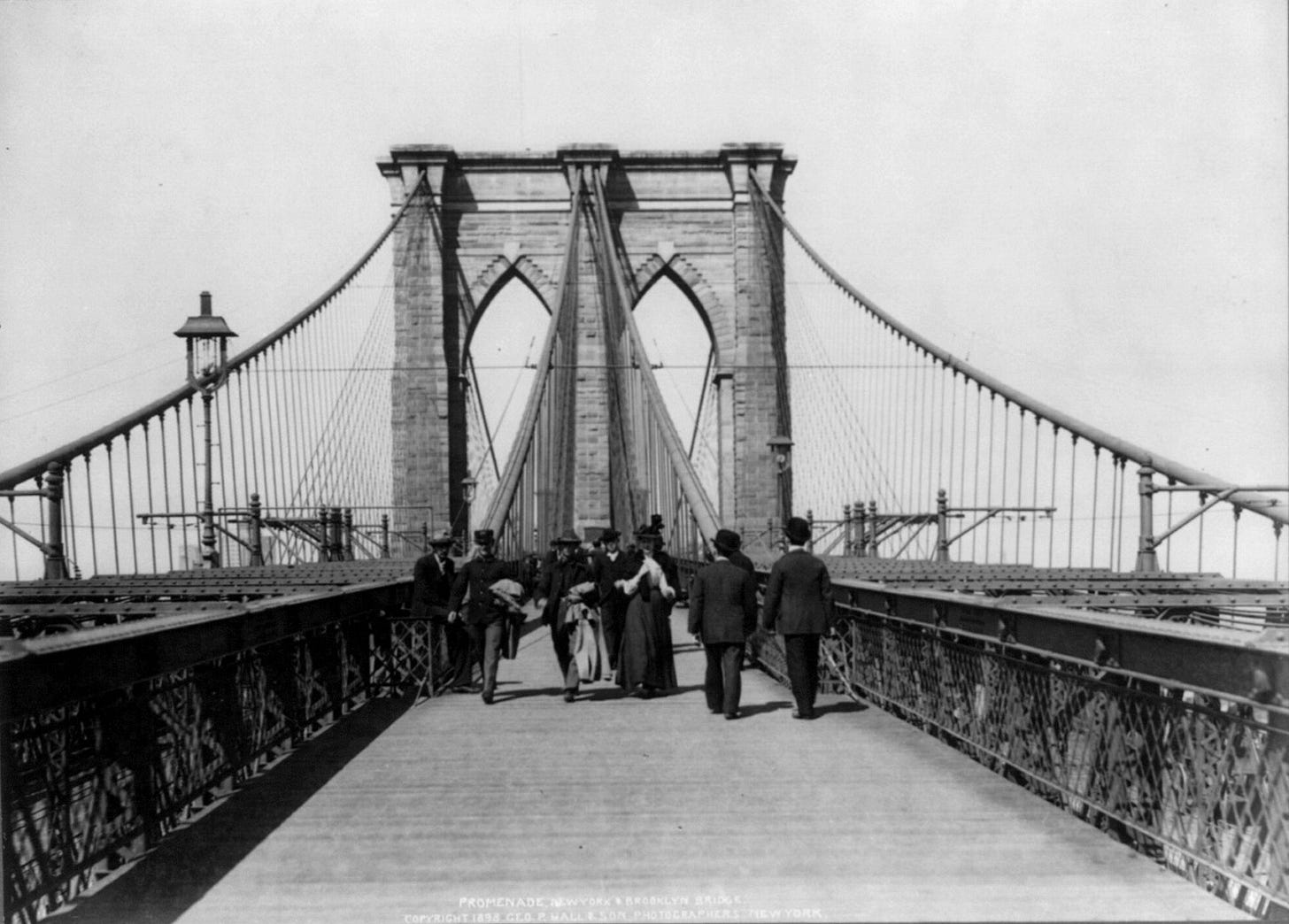Notes on Walking
Image of pedestrians crossing the Brooklyn Bridge c. 1898, via Wikimedia Commons.
I am trying an experiment right now, in which I write this swiftly and with spontaneity, more a sketch of an idea rather than a fully-formed piece. Though I have taught students about the importance of free writing and “first thought, best thought,” this is not the ethos by which I usually produce my own work. In both fiction and non-fiction, careful drafting—rewriting, retyping, the physical effects of which feel a bit like practicing scales—often leads me to an obsessive approach. But for this newsletter to be successful in the midst of my other deadlines, I need it to function more like a notebook: something quicker and more cursory, experience captured and pinned down before it has a chance to twist free.
What the Surrealists called “automatic writing”—writing produced without conscious effort; popularized, also, by the spiritualists of the nineteenth and early twentieth centuries—has a tie, I think, to long distance walking. Both actions are produced by an essential emptying of the mind, which might sound paradoxical; how is writing, how is any kind of forward motion produced, when the mind—conscious thought—is encouraged to go blank? When faced with a lack of words, the words, irrepressible, in fact burble up. Virginia Woolf captures this relationship in her 1930 essay “Street Haunting: A London Adventure,” when she writes that, when walking in a city, “we are only gliding smoothly on the surface. The eye is not a miner, not a diver, not a seeker after buried treasure. It floats us smoothly down a stream; resting, pausing, the brain sleeps perhaps as it looks.”
The brain sleeps perhaps as it looks. I took two long walks this past weekend, which is not terribly unusual for me (I take them often, and, in 2023, I completed the Camino de Santiago, walking 25 to 30 km a day across Spain for five weeks). The first, on Saturday, began at my apartment in Brooklyn, crossed the Manhattan Bridge, and ended up at La MaMa in the East Village to see the Russian director and writer in exile Dmitry Krymov’s new play Metamorphoses (or A Few Ways of Keeping a Child from Running Around at His Great Uncle’s Funeral). It had been a few years since I was last at La MaMa, for a loose adaptation of Olga Tokarczuk’s The Books of Jacob by a Polish theater troupe combining virtual reality with live action; I wasn’t sure if that production entirely cohered.
I’m not sure if Metamorphoses entirely cohered, either; while there were aspects of the show I delighted in—the puppets, for example, particularly the snake and crows, as well as the general sense of chaos—the instances of political satire or reference (the offhand Elon Musk joke towards the beginning, the drone flying close to the audience, and the occasional moments of wordplay—did I hear “glycerine” rather than “glistening,” at one point, when describing a character’s tears?) didn’t quite feel sharp or over-the-top enough to match or underscore the general absurdity happening on stage. A note from the dramaturg references Ionesco, which makes sense, but the animals of Metamorphoses—a dog, a snake, and a camel (all puppets)—didn’t fit quite so neatly and effectively into any one metaphor as Ionesco’s rhinoceros does (or the transformations of Ovid’s own Metamorphoses, for that matter). Still, it was enjoyable, and worth it to see live theater again, which I’ve lately been neglecting.
Walking at a distance, the body moves forward automatically. Crossing a street becomes a kind of autopilot; pausing to let a car or fellow pedestrian pass by is a surprisingly mindless action, too. The body’s relationship to space shifts into that of an observer, freeing the mind to wander into uncharted territory. “Architecture,” wrote the Situationist Ivan Chtcheglov, “is the simplest means of articulating time and space, of modulating reality and engendering dreams.” This quotation comes from his 1953 essay “Formulary for a New Urbanism” (you can read the rest of the essay, as translated by Ken Knabb, here). Perhaps this is why so many writers have had a penchant for long walks: when one is moving in accordance to one’s unconsciousness, every corner of one’s surroundings—the crosswalk, the bodega’s signage, the dead leaves in the gutter—takes on the coy shimmer of possibility that is known as fiction. That is known as dreams.
Parting gifts
- If you’re interested in more writing from me about how our bodies navigate through physical space, try this review of the American writer Lauren Elkin’s excellent novel Scaffolding, which came out in The Los Angeles Review of Books last September. When it comes to transportation, I’ve also previously written about learning to ride a bicycle at the age of thirty and the literature of airports, both for Literary Hub. Or, if you’re intrigued by the brief Tokarczuk mention, try reading my interview with her from 2022.
- There are many, many excellent books about walking, psychogeography, flaneuring, the Situationist idea of the dérive, public transportation, urban space, trains, bicycles, and more. One taking place in New York that immediately come to mind is Teju Cole’s excellent 2011 novel Open City. A more recent novel that I thoroughly enjoyed is the Vietnamese writer Thuan’s Chinatown, translated by Nguyen An Ly, and set, in part, on the Paris Metro.


I’ve always thought walking was the only time my brain managed to switch off just enough to let something real rise. That “autopilot” sensation—the feet moving while the mind drifts sideways—it’s as close to dreaming as you can get while upright.
This was a really intriguing short essay, and I liked the essay you linked as well formulary for a new urbanism